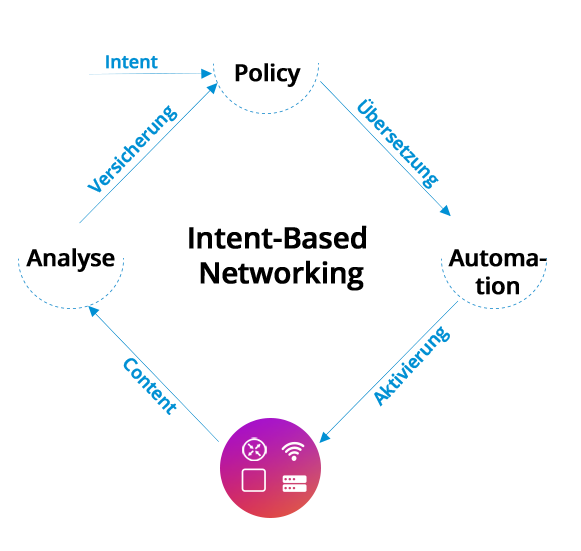Cloud usage, the growing number of devices connected to the Internet and increasing security risks are all factors that demand new approaches to managing networks. Cisco is banking on Intent-Based Networking (IBN). IBN is based on Software Defined Networking and automates most management steps. It recognises problems in the network at an early stage and continues to develop through machine learning.
The requirements placed on networks continue to grow: more and more business processes run digitally; the number of devices connected to the Internet and the volumes of data transmitted are growing sharply; Cloud services put further strain on the network. That is why many IT teams are stretched to the limit when it comes to managing and controlling networks – especially as many enterprises do their administration manually one device at a time. According to Cisco, up to 95 percent of changes in networks are currently executed manually. Accordingly, operating costs are between two and three times higher than the cost of the network itself.
The solution lies in the extensive automation of network management. Cisco is banking on Intent-Based Networking (IBN), a method that captures the administrator’s intent, that is to say, he defines what work the network should do. With the aid of automation and machine learning, IBN implements the required network condition, monitors it continuously and issues an alert in the event of problems or even solves the problem itself.
SDN as a basis
SDN (Software Defined Networking) provides the foundation for this “intelligent” network. SDN decouples the system software from the network hardware by separating the planes for network data analysis and control of the network configuration (control plane) and the plane for data transport in the network (data plane). This enables complete virtualisation of the analysis and control planes, and the control plane can then be programmed directly.
As a rule, the network controller is centralised and can control and manage a large number of different network components such as routers or switches. SDN automates the provisioning of required network resources for dynamic workloads and devices on the basis of parameters such as user type and requirements placed on security or QoS (Quality of Service). This enables the efficient routing and automated control of the data flow in the network in accordance with the load or latency. Further benefits are the central management of the network via uniform sets of rules and enhanced security and availability of the network thanks to a drop in the fault rate.
Further features of Intent-Based Networking
Cisco bases Intent-Based Networking on its Digital Network Architecture (DNA), which combines virtualisation, data analytics and security in enterprise networks. In the DNA centre, the associated management portal, the administrator specifies the properties of the network. His intent concerns, for example, the service quality of the applications, security policies, compliance requirements, company processes and other business objectives. The IBN captures and translates these business objectives into network policies and activates them in the overall infrastructure; the configurations are realised automatically in the network. This is the only way that enterprises can handle the constantly growing number of devices connected to the Internet.

A second important component of Cisco’s Intent-Based Networks is the assurance functions: Cisco Network Assurance Engine (network in the computer centre), Cisco DNA Centre Assurance (enterprise network) and Cisco Meraki Health (WLAN). These functions permanently analyse data traffic in the network and give real-time information on how “healthy” the network is at the moment. IBNs proactively recognise anomalies, bottlenecks and impaired performance within the network and indicate the causes and the areas affected. This gives firms the ability to constantly check whether the network is working as it should. Thanks to complete monitoring and the corresponding adjustments, they ensure that the network is correctly aligned and corresponds to the administrator’s intent.
Machine learning functions are a further very important factor. They analyse the behaviour monitored in the network and use the results as a basis for automated decisions. The network recognises what data is used, as well as by whom, when, where and how it is used. An IBN also creates prognoses regarding problems that could occur in future (predictive analytics) and outlines clear courses of action to resolve them. In other words, with the aid of AI technologies companies can maintain and optimise the desired network condition.
Conclusion: IBN is still in its infancy
Intent-Based Networking has the potential to determine network management at some time in the future. Network teams can define their desired network condition and automatically implement the corresponding policies in the network. Thanks to permanent monitoring, machine learning puts them in a position to react quickly when problems arise.
The greatest benefits are obvious:
- High level of automation: The amount of manual effort in network management is minimised; changes can be configured centrally and automatically transferred to the appropriate network areas.
- Transparency and control: As the status of the network is permanently analysed and monitored, network failures are avoided; the network works as it should.
- Security and compliance: Thanks to monitoring, threats can be detected and contained more quickly. Security is also enhanced as security policies are consistently applied across the entire network.
- Fast and flexible: Thanks to machine learning and automation, the network is able to react quickly to possible performance problems.
Despite all of these benefits, Intent-Based Networking is still in its infancy. However, with Cisco forcefully pushing this new approach to network management, a further spread can be expected in the coming years. As SDN is the basis for IBN, the trailblazers will be those companies that have already opted for SDN. If SDN environments continue to spread in enterprises, this will also have a positive impact on the deployment of Intent-Based Networking.

Questions?
Just ask!
I am Alexander Fest from the HCD sales team. I will be happy to advise you or assist you with any questions. You can phone me on +41 58 590 110-0 or reach me using our contact form.
Contact us